My old friend from North Carolina, Robin Cunningham, decided this year to fly to England for the New Year and play in the traditional Hastings tournament. He did it once before and enjoyed the experience.
This year, he’s doing more than just enjoying it: He’s kicking butt! In the first two rounds he defeated Grandmaster Glenn Flear and drew Grandmaster Daniel Gormally. This is a pretty impressive beginning to the tournament for a player with a FIDE rating of 2205.
I should mention that Robin has been higher-rated in the past — he’s a FIDE Master and has been over 2400 USCF. Also, Flear is not the first GM that he has beaten; he beat GM Anatoly Lein back in the 1990s, and he might have beaten others before the USCF online records began in 1991. However, this game may be his life masterpiece because it included (sort of) a queen sacrifice and it was overall just a terrific, well-played game.
So how do you beat a Grandmaster, when you’re just a FIDE Master? Let’s see.
How to Beat a Grandmaster.
Rule Number One: Play White.
Check! Robin had White against Flear.
Robin Cunningham – Glenn Flear, 12/28/2015
1. e4 e5 2. Nf3 Nc6
Rule Number Two: Don’t play the opening your opponent has written a book about. Flear has written not one but two books about the Ruy Lopez. So Robin plays the Four Knights Game.
3. Nc3 Nf6 4. Bb5 Bc5 5. Nxe5 …
The “fork trick” is a nice equalizing weapon for Black. But for White it’s … a nice equalizing weapon. Not something you usually want to play unless your opponent is a GM.
5. … Nxe5 6. d4 Bd6 7. f4 Neg4 8. e5 Be7 9.ef Nxf6 10. O-O O-O-O 11. f5 …
I very much like this assertive, space-gaining move. A pawn on f4 is interested in only one thing: moving on to f5 (and f6).
11. … d5 12. Qf3 c6 13. Bd3 b5
Maybe overreaching a little bit?
14. Ne2 Re8 15. g4!? …
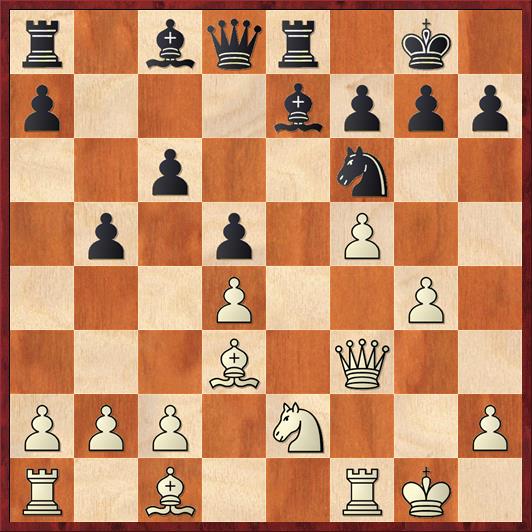 Position after 15. g4. Black to move.
Position after 15. g4. Black to move.
FEN: r1bqr1k1/p3bppp/2p2n2/1p1p1P2/3P2P1/3B1Q2/PPP1N2P/R1B2RK1 b – – 0 15
Rule Number Three: Make your opponent think that you’ve blundered.
This is by far the hardest step in beating a Grandmaster, because if a Grandmaster thinks you’ve blundered, you probably have blundered.
This move opens White’s kingside up to big-time counterplay from Black, and Flear from this point plays as if he is determined to bust White’s idea.
15. … Ne4!
An enterprising pawn sacrifice, which Robin cannot afford to accept. If 16. Bxe4 de 17. Qxe4 Bf6 18. Qd3 (18. Qc6? Rxe2 is almost certainly won for Black.) 18. … c5! and Black is coming at White from every direction.
This launches an interesting sequence of moves where White tries to evict Black’s knight and Black tries to keep it on e4 by tactical means.
16. Ng3 Bh4 17. c3 …
It’s still too early to take on e4, as the d4 pawn was too weak. Now is where I think Flear starts to go wrong.
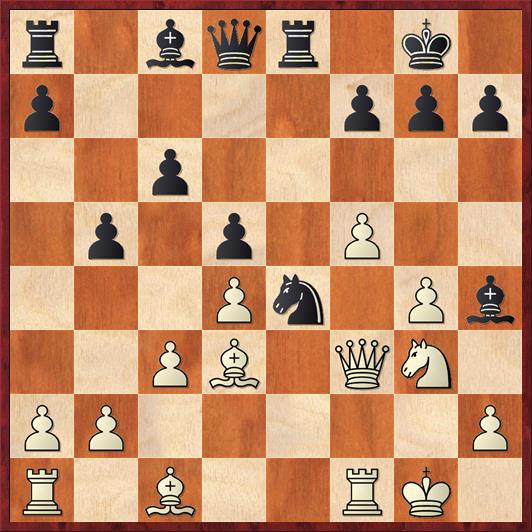 Position after 17. c3. Black to move.
Position after 17. c3. Black to move.
FEN: r1bqr1k1/p4ppp/2p5/1p1p1P2/3Pn1Pb/2PB1QN1/PP5P/R1B2RK1 b – – 0 17
17. … Bb7?
This is certainly the principled move, but is the pawn sacrifice really sound? Methinks not. I think that there is a strong case to be made for playing 17. … Ng5, striving for a Nimzovichian total blockade of the kingside.
18. Nxe4 de 19. Bxe4 …
Kudos to Robin for snatching the material. There are lots of threats brewing, but Robin has enough courage and confidence in his pieces to not back down.
19. … Qd7 20. Bf4 Re7
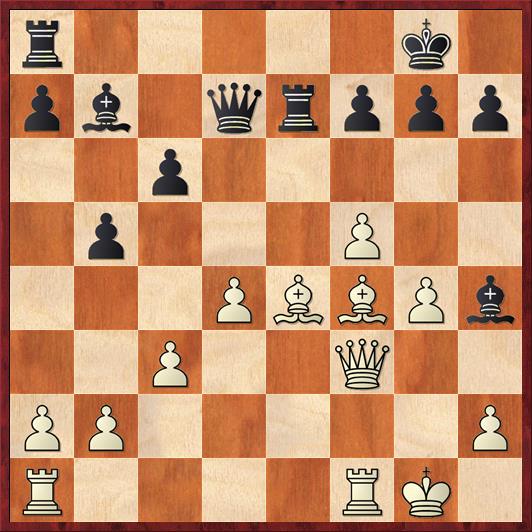 Position after 20. … Re7. White to move.
Position after 20. … Re7. White to move.
FEN: r5k1/pb1qrppp/2p5/1p3P2/3PBBPb/2P2Q2/PP5P/R4RK1 w – – 0 21
A completely logical move, because Black would like to play … c5 but he needs to add a defender to b7 first. Also, this threatens to double on the e-file. In fact, it’s starting to look as if White is in trouble, but Robin either foresaw or discovered a resource that Flear missed. The key point is that the rook is now in the way of Black’s bishop, which thereby runs out of flight squares.
21. f6!! …
Absolutely a superb move, which to me is even better than the sort-of queen sacrifice that follows. First, it’s just a cool conception, luring the bishop back in order to trap it. But it also required really precise calculation, because White had to anticipate the consequences of the counter-sacrifice 21. … Rxe4!?
21. … Bxf6
If 21. … Rxe4 22. Qxe4 Black has three ways to proceed: 22. … Qxg4+, 22. … c5, or 22. … Re8. After 22. … Qxg4+ 23. Qg2! Black cannot avoid trading queens, and after 23. … Qxg2+ 24. Kxg2 c5+ 25. Kh3! Black has too many things hanging. 22. … c5 looks a little better. The only move for White to save the game is 23. Qf5! Then after 23. … Qc6 24. d5! forces the trade of queens, at the cost of a pawn. After 24. … Qxd5 25. Qxd5 Bxd5 Black’s bishops are extremely active, and it would be easy for White to blunder with 26. Rad1? Bc4! winning back the exchange. But I think that after a move like 26. Bd6 Black does not really have enough compensation. Finally, there’s 21. … Rxe4 22. Qxe4 Re8, which is again met by 23. Qf5! Qxf5 24. gf Re2 25. Bg3 c5 26. Rf2 and that hiss you hear is the steam going out of Black’s attack.
22. Bf5! …
A key tempo move. Again Robin gets an A+ for alertness. The move 22. g5? would give Black drawing chances after 22. … Rxe4! (finally) 23. Qxe4 c5 24. d5 Qg4+ 25. Qg2 Qxg2+ 26. Kxg2 Bxd5+ 27. Kf2 Be7.
22. … Qd8
For a little while I thought that Black might have done better to play 22. … Qe8, but Rybka set me straight. White has the cold-blooded answer 23. Qg3 Re2 24. Rae1! An amazing conception: the rook on e2 is pinned, and Black cannot retreat his bishop either to e7 (because the rook would fall) or d8 (because the back rank, after 24. … Bd8 25. Rxe2 Qxe2 26. Re1!).
23. g5 c5
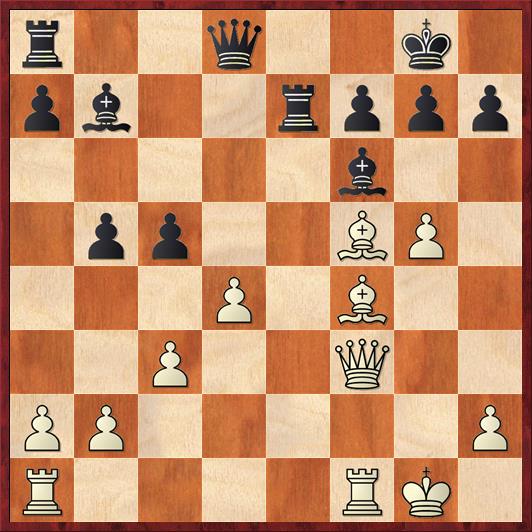 Position after 23. … c5. White to move.
Position after 23. … c5. White to move.
FEN: r2q2k1/pb2rppp/5b2/1pp2BP1/3P1B2/2P2Q2/PP5P/R4RK1 w – – 0 24
Flear finally gets to play the move he has been setting up since move 17, but Robin has a saucy response prepared for him!
24. gf! …
Rule Number Four: Sac your queen!
Actually, this isn’t really a sacrifice, because Robin gets full material compensation for his queen. Still, any time you trade a queen for smaller pieces, you create a very imbalanced type of position that is unfamiliar to everyone, even grandmasters.
There were still plenty of ways for Robin to go wrong. If he plays a more conservative move like 24. Qg4?, it gives Flear time for 24. … Bxd4+! 25. cd Qxd4+ 26. Rf2 Qd5, with a winning attack.
The computer (the eternal spoilsport) prefers a bishop sac rather than a queen sac, with 24. Bxh7+ Kxh7 25. Qh5+ Kg8 26. gf Re6 27. fg Rg6+ 28. Bg3 etc. While I agree that this is good for White, I still think Robin’s move is better, and I will explain why below.
24. … Bxf3 25. fe Qxe7 26. Rxf3 cd 27. cd Rd8 28. Rd1 Qe2 29. Rfd3 Qxb2 30. R3d2 …
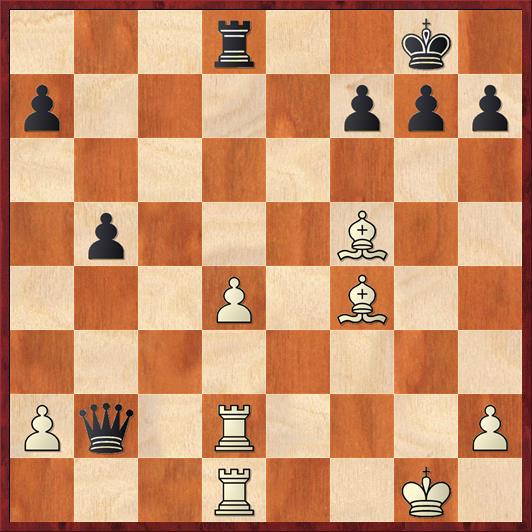 Position after 30. R3d2. Black to move.
Position after 30. R3d2. Black to move.
FEN: 3r2k1/p4ppp/8/1p3B2/3P1B2/8/Pq1R3P/3R2K1 b – – 0 30
The smoke has cleared, and Flear has managed to get to a position with more or less equal material: queen and two pawns for rook and two bishops.
Nevertheless, I consider this position to be completely, 100 percent won for White. Black’s two extra pawns would be an issue only if they were far advanced, but in fact White’s single d-pawn is stronger than Black’s fleet of pawns on the kingside. White’s rooks are working well together, doubled and “pushing” the d-pawn from behind. And the two bishops are the pride and joy of White’s position. Black has nothing that can fight against them, and they make it completely impossible for Black to blockade the d-pawn.
To my very great surprise, Rybka did not agree, and evaluated the position as essentially equal (+0.21 pawns for White). I think this is a case where the computer is out of its depth, because it cannot see the absolute impossibility of setting up a blockade. No doubt the computer here would put up excellent resistance and find lots of tricks and traps with its queen to confuse the issue. But I don’t see anything resembling an actual plan for Black.
I’d be interested in finding out whether one of the current top-of-the-line programs, like Houdini or Stockfish, would come to a different assessment than my old copy of Rybka 3.0. But even if they agree with Rybka, I don’t think I would believe them.
That brings up a final point…
Rule Number Five: Don’t forget that your opponent is not a computer.
Glenn Flear is a human being. He tries to set up some tricks and traps, but Robin just crushes him like a bug from this point forward.
30. R3d2 Qb4 31. Bg3 g6 32. Bh3 h5
I would have played 32. … f5, trying to block the bishop’s lines, but of course it would just find a new diagonal on g2.
33. d5 Qc3 34. d6 Qe3+ 35. Kh1 h4 36. Rd3 Qe2 37. R1d2 Qe4+ 38. Bg2 Qc4 39. Rd4 hg 40. Rxc4 bc 41. hg c3 42. Rc2 Rxd6 43. Rxc3 Rd7 44. Rb3 Kg7 45. Rb7 resigns
A memorable, once-in-a-lifetime performance by Robin. To sum up, here are Dana’s five can’t-fail rules for beating a grandmaster. (Note: I have never beaten one myself.)
- Play White.
- Don’t play the opening he has written a book about.
- Make him think that you’ve blundered.
- Sacrifice your queen.
- Don’t forget that he is human, not a computer!



{ 5 comments… read them below or add one }
I am sitting here watching Stockfish (admittedly on a single processor) analyzing the position at move 30. The evaluation is very slowly going up over time. It consistently favors 30…Qc3 (currently 0.71) and considers the game move 30…Qb4 as 1.00.
I feel quite certain I’d lose as Black, barring a serious mistake from my opponent. Admittedly it is a position ripe with potential serious mistakes: any time White puts a piece on an undefended square he’s just asking to get forked.
Winning it vs. a GM is another matter, though. Kudos to your friend!
Stockfish is up to 0.73 at 27 ply. Its best line is completely bizarre, though; I don’t think it agrees with you that there’s no blockade of the d-pawn. 1…Qc3 2.Be4 a5 3.Kg2 h5 4.Rc2 Qb4 5.h3 g6 6.Be5 Qe7 7.Re2 Rc8 8.Rf1 f5 9.Bd5+ Kh7 10.Kh2 Rc3 11.Bg2 Kg8 12.Bf3 Qa3 13.Ref2 Rxf3 14.Rxf3 Qxa2+ 15.Kg3 b4 16.h4.
Komodo 9.02 assesses the position after 30.R3d2 as +1.49 (at a depth of 27 ply).
On my blog I wrote an article about different ways how to beat a stronger player (the 3 examples are about grandmasters):
http://chess-brabo.blogspot.be/2013/12/how-to-win-from-stronger-player.html
Robin Cunningham finished with 5 points out of 9. He played against 6 grandmasters, with one victory, three draws and 2 losses.
http://chess-results.com/tnr201785.aspx?lan=1&art=9&fed=ENG&wi=821&snr=33
A wonderfully enlightening annotation of a stunningly brilliant game! Thank you Dana for alerting me to your friend Robin’s magnificent achievement. (Hmmm, a man named Dana writing about a man named Robin… yet you’re both Americans, not Englishmen? There’s one for the books!)
I featured Cunningham-Flear in two separate posts in my upsets-themed Facebook group called The Fish That Roared.
FM Jon Jacobs